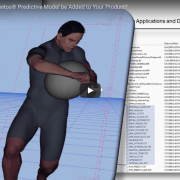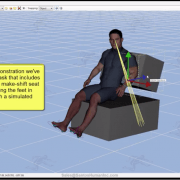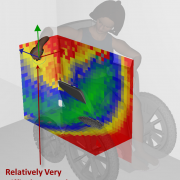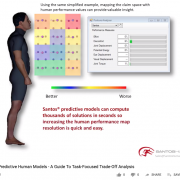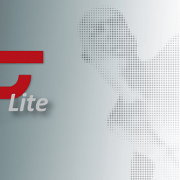Video Demo: What’s the Difference Between a Predictive Human Model and a Traditional Digital Human?
As you might expect, I spend a lot of my time talking to people about Santos® technologies. When they are familiar with digital human modeling at all, they’ll often say things like, “Digital human models have been around for decades. Our teams have tried them but feel they’re difficult to use and ultimately not that much of a value-add. Why should we be interested in yours?”
For those of us who have been involved from the very beginning in what is now commonly referred to as Santos®, the answer is obvious. But, simply saying, “Santos provides the ability to predict human physical behavior and performance“, isn’t meaningful before also providing a great deal of additional background information. This blog post attempts to make one of the many significant values of this unique capability a bit more obvious.
The video linked to below provides a side-by-side comparison highlighting the difference between using a truly predictive human model (on the left) versus the way in which a more traditional digital mannequin is used (on the right). While Santos® predictive models provide significant advantages for human-centric design and evaluation in any industry, this video focuses on a contrived cab space development application.
How to Watch the Video
Both the left and right sides of the video were created using a single digital human character within our flagship product, Santos Pro. The right side of the video mimics the traditional way in which digital human models were designed to be used. The left side demonstrates the use of Santos predictive models.
The right side of the video only needs to be watched once through the first iteration. There’s a lot happening on the right side of the video at first so it’s not only initially more interesting, it’s almost impossible not to watch. In comparison, the activities on the left side are rather boring at first as the user is just setting up the constraints required to define an operator task. So go ahead and focus on the right side through the first iteration. The activities shown on the left will complete at about the same point in the video as the 1st iteration of the activities on the right so you’re not going to miss anything. Note, however, that the two sides only complete at about the same time because the right side has been sped up by about 5x and that’s an important point. It takes less than a minute to set up the predictive model task on the left but takes about 5 minutes for a highly experienced, expert user to manually rotate individual joints into position on the right.
After the first iteration of activities on the right is complete, that clip just repeats over and over until the end. But you’ll find you don’t have to watch the right side very long to see that manually rotating digital mannequin joints is non-intuitive, time-consuming, and tedious. In addition, it is clearly a highly subjective process where compromised, even non-human-looking, results are a frequent option. And as if that wouldn’t be frustrating enough, consider there are no economies of scale to using a digital mannequin. Every design option explored requires another round of subjective and tedious manual joint rotations. And then, after all that effort, when you’re all done, what is it you actually know? It’s no surprise that many design teams consider the use of digital human mannequins an obstacle as opposed to a solution that can be used to bring better, customer-focused designs into production sooner.
In contrast, use of a truly predictive human model (the left side of the video) allows multiple and even competing task objectives to be evaluated in a system-of-systems approach that, in this example, includes seat location, steering wheel and pedal use, and even a vision requirement. The advanced predictive nature of Santos enables your teams to identify Human-in-the-Loop requirements at the earliest stages of product development while change is still a cost-effective option.
SantosHuman Inc. When getting it wrong is not in the budget.
Take a look and let us know what you think. We’d love to hear from you.
Santos® Pro provides a foundational platform for truly human-centric design through a full range of predictive human modeling capabilities. Learn more about our complete product line.

